“Sometimes I had to scare the prisoners”, S-21 Interrogator Says about Using Violence
Witness Prak Khan continued his testimony today. He gave further information on detention conditions, rape, prisoners having been subject to blood withdrawal of which they died, and treatment of Vietnamese civilians and soldiers at S-21. Under questioning of the Nuon Chea Defense Team, he testified about methods of interrogation. Defense Counsel Victor Koppe questioned him on an alleged coup d’état that was planned by Koy Thuon and other cadres.
Vietnamese
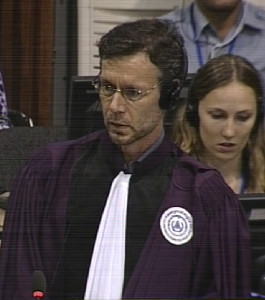
Senior Assistant Prosecutor Vincent de Wilde
All parties were present, with Nuon Chea following the hearing from the holding cell. The floor was granted to the Co-Prosecution. Senior Assistant Prosecutor Vincent de Wilde wanted to know what the Vietnamese prisoners were interrogated about. He replied that the Vietnamese were asked to repeat what Chan had read out. He had read out the confession that they entered the Cambodian territory to spy. This was broadcasted over the radio so that the Vietnamese could hear this and know that these people had been arrested. The names were the correct names of the prisoners. Some were soldiers and some were civilians. The confessions were broadcasted on the radio at 7 am every morning. The speech was interpreted. Mr. de Wilde asked whether he properly understood him that they were promised to be freed if they confessed, which the witness denied. He never saw refugees, but saw fishermen who were caught.
Mr. de Wilde said that he had referred to a baby that was thrown from the roof of a building in his Written Record of Interview and asked what happened. Mr. Khan answered that when he was guarding near the fire station, there was a tamarind tree to the south of the fire station. There was a two-story house that was used as an office to receive prisoners. He stood guard at the ground floor. A Vietnamese family arrived: husband, wife and a young child. The child followed the parents and two cadres dragged the child away from the parents and took it out of the office. They dropped the child from the first floor. One of the people who had dropped the child signaled him to bury it.
Mr. de Wilde inquired about the policy towards Vietnamese and asked whether Duch told him that the Vietnamese had to be considered the enemy. Mr. Koppe interjected and said the question had to be more specific: what was the time frame? And was he referring to Vietnamese civilians living in Cambodia, or Vietnamese civilians living in Vietnam, or Vietnamese soldiers?
Mr. de Wilde specified the question. Mr. Khan replied that there were no Vietnamese civilians living in Cambodia at the time anymore, since they had all left the country of had been killed since 1975. They were told that the Vietnamese were the hereditary enemy of the Democratic Kampuchea Party when there was an armed conflict.
Mr. de Wilde referred to a document, which said that there were Vietnamese forces in the country, because “the traitors had concealed them in the country”.[1] Mr. Khan said that he did not hear this statement before. The situation was that the Democratic Kampuchea forces were fighting and advancing into the territory of Vietnam, he said.[2] They could even hear gunfire at S-21. This took place during the last month of 1978, during which time they did not interrogate prisoners anymore. On 2 or 3 January, they took prisoners out. On January 7, they defended themselves. The forces of Pol Pot retreated at that time. “And the situation was rather chaotic at the time”. They retreated alongside the sewage canal. He saw prisoners being escorted out of the prison, “and it is likely they were executed”. He had not witnessed the executions himself. There were 30 or 40 prisoners on these trucks. He had made his own conclusion that they must have been transported to Choeung Ek.
At around 3 pm on January 7, prisoners were allowed to walk inside the compound of the prison: Chan, Mey, Vann Nath and other prisoners fled to Amleang, Trapeang Chrey in Kampong Speu. This was because Duch and others were also fleeing. A vehicle tried to intercept them at around 6 am, but they continued fleeing. With this, Mr. de Wilde finished his line of questioning.
Blood drawing
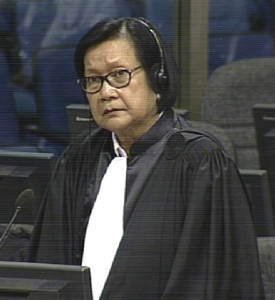
Civil Party Lawyer Chet Vanly
The floor was granted to the Civil Party Lead Co-Lawyers. Civil Party lawyer Chet Vanly sought clarification with regards to withdrawing blood. She wanted to know when this took place. He estimated that it happened in 1977 or 1978. He did not know who authorized the blood drawing. The medic conducted it in the room near the main entrance at Tuol Sleng. After the blood had been withdrawn, the tubes were removed and prisoners were thrown into the corner of a room and piled up there. They were thrown onto a cart and buried. He did not witness that last act. However, he saw fresh dirt used to cover the dirt at 6 am. Prisoners could not move when their blood had been withdrawn, but they were still breathing. He did not know how many sacks of blood each prisoner gave. “However, each prisoner had their blood fully withdrawn”. When seeing this, he “was shocked … but [he] did not show it to anyone”. He said that he “knew what was right and what was wrong”, but he did not dare to say anything. There were three or four more medical staff members there aside from Try. To his knowledge, Try had later been arrested.
Rape and suicide
He witnessed and knew that there was one incident of rape. He could see that the woman was sent back after she was raped. It was around 1 or 2 pm at the back of a house where he was interrogating prisoners. She was taken to the ground floor to be interrogated and raped by Touch. A messenger by Chan heard about this and Touch was arrested. “Touch’s legs were not shackled, so he fled to the second floor of the building, and he jumped from the top of the building and touched the electric wires and survived” He had not heard about any other incidents.
He knew Lach Mean – he was working with him. Lach Mean was sent to work with him when Mean was around 13 or 14 years old. He did not know about the other incidences that Lach Mean had mentioned. Touch was arrested, detained and killed.
He heard that one prisoner had grabbed the weapon of a guard, another took a kerosene lamp to burn himself, and other instances.
Interrogations
There was no specific period to detain prisoners. Whenever they were needed for interrogation they would be sent to be interrogated. Some of the prisoners were detained for half a month or a month before being interrogated. Each room had a window and a door, but they were completely closed. There was a table, a chair, shackles, cables, a pot, and a container for the prisoners to relieve themselves in. They were handcuffed and blindfolded when they were being brought into the interrogation room. The blindfold was taken down, but they remained handcuffed. He never told them the offenses they had committed, nor did the upper echelon tell him the offenses they had committed or the network they belonged to. There were no annotations for interrogations. It usually took several months to interrogate prisoners. In other cases, several days or a few weeks were sufficient. He had to interrogate prisoners from 7 am – 11 pm, 2 pm until 5 pm and 7 pm until 11 pm.
The prisoners were told to sit on a chair facing the interrogator. On some occasions, they were told to sit on the floor, “because of the torture”, and they fell to the ground. He never interrogated foreign prisoners. There were Vietnamese, Australian and American prisoners at the prison. Duch and Chan interrogated those prisoners in a public venue. This would be seen by everyone walking past. “No one had the command of English”, so only Duch and Chan could interrogate them. He could recognize one foreign prisoner: David Scott. He learned from Keu that the Australian and American prisoners were burned on the road leading from Wat Mohamantrei to Wat Toul Tom Poung. Used tires were put onto the prisoners and then they were burned.
He never witnessed executions himself. It happened frequently that prisoners were transported on Chinese-made trucks that were fully covered. He learned about the executions at Choeung Ek after he was interviewed by a foreign journalist at Choeung Ek. Executions also happened in S-21. They were committed by Chan, “who had a big built and a dark complexion”. The prisoners were hit on their neck with a club and thrown into the pits afterwards. The executioners would tell them about it during lunch time.
Detention conditions
Prisoners were brought in both at night and day time. Only a few prisoners were relieved to work as mechanics, painters, artists or carpenters based on their expertise. The security guards at the outside were fully armed, even if they were only ten years old. Security guards inside the compound were not armed.
The floor was granted to Judge Jean-Marc Lavergne, who asked whether it was his statement that the Vietnamese had either “left or had been killed”, which the witness confirmed. There was no order to allow the Vietnamese to return to their country. “Lots of Vietnamese people had been cleansed during the Lon Nol regime”, so not many Vietnamese people were living in the country by the time the Khmer Rouge took power. When the Khmer Rouge took control of the country, he did not hear of any principle to return Vietnamese civilians to their country.
He had heard of the expression of a Khmer body with a Vietnamese mind. This meant that they had the ideas and views of the Vietnamese, although they had Khmer bodies.
He did not hear of anything of importance about Cham people. “During the regime, there was no distinction made between Cham and Khmer people”. There were Cham detainees, but he did not know any details about their detention. He could not recall why they were arrested.
Judge Lavergne sought when he saw the dead bodies: before or after the fall of Phnom Penh? Mr. Khan answered that soldiers of the former regime were arrested and gathered at the court of first instance at Ta Khmao and killed later. He could recall someone who was a former colonel and had a French wife.
At this point, the President adjourned the hearing for a break.
Lon Nol soldiers
Judge Lavergne sought more detail about the fate of the former Lon Nol colonel. Mr. Khan said that this official’s wife and children were killed with him. A few days after the liberation of Phnom Penh, fighting still occurred in Phnom Penh, even a month later. Some former soldiers remained inside buildings and were taken away and killed. “If we had not killed those people they would have killed us back”, he said. He was at Ta Khmao at the time. He said he had not only heard about this, but witnessed the actual killing. “Since I was asked to bring all those people on the vehicles, and I was also asked to stand guard”. There were not more than 50 people.
Judge Lavergne then wanted to know whether he heard the names of certain senior leaders in some confessions. Mr. Khan replied that the confessions mentioned Ruos Nhim and Huos Nhim. No other names were mentioned.
The floor was handed to Nuon Chea Defense Counsel. As a preliminary remark, he said that the defense team assumed that they would have time to question the witness until 10:40 am on Monday, since this was the time given to the Prosecution earlier. Second, he said that they had filed a Rule 92 motion “to use certain S-21 statements”. [3] They argued that Duch’s testimony had shown that Koy Thuon had not been subject to maltreatment or torture. He said that the defense team might use document today already.
Mr. de Wilde answered that they had only started at 9:30 am today and that Judge Lavergne had also used ten minutes today. International Civil Party Lead Co-Lawyer Marie Guiraud said that Civil Parties intended to respond to the motion and objected to use of three confessions mentioned in the request. She therefore requested the Chamber to prohibit the use of this document today. Ms. Guissé said that the calculation by the Prosecution did not add up and that the full scheduled time should be granted to the defense teams.
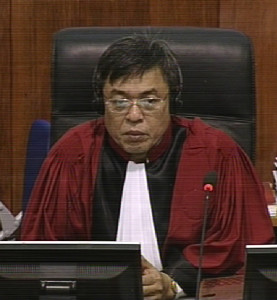
Trial Chamber President Nil Nonn
Trial Chamber President Nil Nonn said that the Chamber would not decide and consider submissions that were not in line with the rules of the Chamber. The Chamber would cut off the floor when questions were asked that were not relevant. “I am strict on the time”. Judge Fenz clarified that the instruction was not to use the document until the decision had been made by the Chamber, which would follow on Monday after all parties had had the opportunity to respond.
Mr. Koppe then started his line of questioning and asked the witness to repeat the name of the colonel: Kes Tara. He was arrested and then sent to the Court of First Instance at Ta Khmao, where the witness was standing guard.
Mr. Koppe wanted to show a list of seventeen “traitors from the special zone”, which was granted.[4] Mr. Koppe pointed to number two of this list, Kham Phou Hong, and wanted to know whether he had ever heard of this person. The President said that it was to be pronounced Kham Phoun. The witness had never heard of this person. Mr. Khan himself did not take part in the execution. He knew that Oeun from Battalion 138 took part in it. Division 308 from the Special Zone “did the task”. He did not know who ordered him to do so. There was an order from Oeun to execute the prisoners of war.
Turning back to his original set of questions, Mr. Koppe said that the witness had been part of Division 12 and 103rd Battalion and asked whether this was correct. Mr. Khan replied that he was not a member of the battalion but “simply a youth”. He was a combatant in Division 703, Regiment 38. He could not recall the number of battalion that he belonged to.
Mr. Koppe said that a book indicated that he was a veteran form the 103rd battalion of Division 12 and asked whether this was incorrect.[5] Mr. Khan said that he could not remember the number of the battalion.
Mr. Koppe wanted to know whether he was ever involved in active combat with Lon Nol soldiers during the liberation of Phnom Penh. He replied that he was engaged in active combat from 1973 or 1974 until the time that he entered Phnom Penh. He saw combats being shot and wounded. “They were wounded and died one after another”, was his answer. Those combatants who were wounded but did not die, they were sent to the hospital. After their recovery, they were sent back to the battlefield. Mr. Koppe asked whether these comrades received blood from the other combatants in the hospital. Mr. Khan said that he was not sure on this issue. “I have never heard of the blood infusion. However, surgery did happen on the wounded soldiers. But [no] major or significant operations were conducted”. Mr. Koppe asked whether he or his comrades in the 103rd battalion were ever asked to donate blood, which the witness denied.
Mr. Koppe then wanted to know whether he had heard of a Division 12 combatant called Meng Hak. Mr. Khan said that he belonged to Division 12 before belonging to Division 703, but had never heard of Meng Hak. He had never heard of Duch engaging in active combat. “He simply made mention about the engagement in the ministries and administrative tasks. He never made mention of active combats at the battlefields”.
Vietnamese civilians and soldiers
His battalions never encountered Vietnamese. “We never killed Vietnamese civilians or soldiers”. Mr. Koppe then wanted to know what he had meant when talking about the cleansing of Vietnamese under Lon Nol. He replied that “Lon Nol had the plan to cleanse the Vietnamese people from the Kampuchean territory”, in 1970 and in particular from Koh Kantheay Island below Neak Leung. The witness had been there and saw corpses and bones. Lon Nol soldiers destroyed homes and killed them. He did not see the acts of killings, but saw the skeleton remains when he engaged in combat near Koh Kantheay below Neak Leung.
After the liberation of Phnom Penh, when the situation in Phnom Penh was calming down and there was no fighting, his unit was sent to work in a rice field in Prey Sar. They were there during the day time and slept in Phnom Penh at night time. This took place every day for a limited amount of time. Their sleeping quarters were at Kba Thnol. Some of them were recruited from the military unit to go to the Sisowath School. Many of them were staying there. They were told that they were the reparatory force that were to be deployed in embassies all around the world and that some would become pilots. He waited there for “quite some time” before he was sent to Tuol Sleng. He worked at Prey Sar for one season. They had not harvested the crops yet. There was no re-education center at the time and Tuol Sleng Prison was not yet established. He heard about S-24 later on and that Huy Sre was in charge.
Mr. Koppe asked what happened to comrades of Division 703 who were seen or as having or actually had committed offences before he worked at S-21. Mr. Khan replied that he did “not notice anything with soldiers from Division 703” before he worked at S-21.
Mr. Koppe asked what happened to those who were seen as enemies or as seen as opposing the CPK. Mr. Khan answered that “such killings” did not take place before the establishment of S-21, and that many of these killings took place in 1977.
Mr. Koppe showed a document Brief Biography of Released Soldiers of Company 44 to the witness.[6] There were around 40 names on the document. He pointed to a person called Tang Met
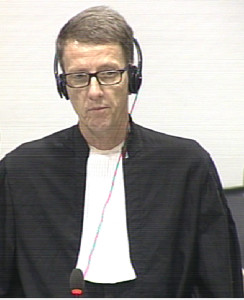
International Nuon Chea Defense Counsel Victor Koppe
Mr. de Wilde said that they had a list that indicated that these prisoners were not actually released. Mr. Koppe said that another document indicated they were.[7] Mr. Koppe asked him to react to the last column. Mr. Khan said that he was not familiar with the names, since they were in different units. “For that reason, I did not know the reason for the release. I only knew what I experienced”. Mr. Koppe asked whether he knew number 18 on the list. This person was Ea Kok, whose reason for arrest was “crashing into the vehicle of Brother 703”. Mr. Khan replied that he did not know. Brother 703 would be the commander of Division 703, he said. Number 20, Hin Chi, was implicated by Heng Oun for poisoning cadres. Mr. Khan replied that he did not know that person. Mr. Koppe said that the accusations for 30, 31 and 32 were “moving as a spy”. He said he did not know anything about this person. Mr. Koppe asked about number 45, Seang Eng Ny, and wanted to know whether he had heard of this name, which the witness denied.
Mr. Koppe asked whether he had heard that combatants who committed such offenses were released. He answered that “they would not be released” if there were such incidences. From his experience at S-21, “they would never be let out”. If people were released, this would have happened outside S-21.
Before the lunch break, Mr. de Wilde pointed out that the first name, Tang Ket, was also on the OCP S-21 list[8] and on a DC-Cam document, which indicated that this person had been imprisoned at S-21.[9] At this point, the President adjourned the hearing for a break.
Enemies
After the lunch break, Mr. Koppe referred to a speech by Son Sen who talked about various categories on 9 October 1976.[10] Mr. Koppe read an excerpt of this speech, which set out three categories of enemies: those who were dangerous and had to be “absolutely purged”, those who were less dangerous and had to be repeatedly re-educated, and those who had been “merely incited” by the enemy and needed to be re-educated. Mr. Koppe asked whether the witness had heard Duch, Son Sen or any other senior cadre, talk about these three categories. Mr. Khan replied that he was questioned on this topic, particularly in relation to the training sessions. In 1977 and 1978, there were different arrests and study sessions. The principle of distinction of soldiers and those who opposed Angkar had to be implemented inside and outside S-21.
The three categories for those who fell within the categories that were not considered as light considered were sent to Prey Sar. Those who were considered to fall in the serious category would be sent to S-21. Mr. Koppe wanted to know whether he knew anything about the process of prisoners coming in, having their photograph taken, and maybe being sent to S-24 afterwards. Mr. Khan did not know anything about this. This prompted Mr. Koppe to read an excerpt of the Written Record of Interview of the chief of the photography unit Nhim Kim Sreang had said that those people who were sent to farm rice were “minor people” and that he photographed them at the rice fields.[11] Mr. Koppe wanted to know whether this was something he knew at the time. Mr. Khan said that he had no knowledge of this issue. The work at Prey Sar in general was beyond his knowledge, the witness said.
Mr. Koppe asked whether he was in a position to tell whether a truck leaving S-21 was leaving for Choeung Ek, Prey Sar or maybe a third location as a guard. He replied that the education location at Prey Sar had not yet existed during the time when he worked as a guard. He did not know where the trucks were sent to later. The principle of S-21 “was that no prisoners after [being] interrogated was relieved”, he said. He did not know whether people he interrogated were relieved later.
The houses of interrogation were of no specific distance from S-21. They were “a little bit outside the fence”. There was a zinc fence outside those houses. Interrogation houses were located to the east of the gate of S-21. Those houses were located to the north of S-21 along the road leading to the outer fence. Duch’s house was located close to Monivong Boulevard. There was another block of houses that was used for interrogations. He used the same house for interrogation until he left. The houses were not more than 100 meters away from the prison.
At first, he interrogated prisoners to the north of the gate of S-21.
Working as an interrogator
He could not recall the month or year that he started working as an interrogator. He had to complete his task “as soon as possible”. He estimated that it might have been in mid- or late-1976.
Mr. Koppe said that he had identified his signature on the confession by Eng Meng Hen alias Chhon who he had interrogated in February 1977. He said that this was the first prisoner he had interrogated, but that it was before the date indicated. He said that he learned from the interrogator how to interrogate.
Mr. Koppe wanted to know how many people he had interrogated in total. The witness did not know. Mr. Koppe said that DC-Cam had found 53 documents with his name on it. The witness reiterated that he could not recall the number of interrogations. He also said that some of the confessions seemed to bear his signature, but were not his, because the handwritings on the confession were not his.
He was in Group 3. Mr. Koppe said that a confession of May 1977 indicated that he was a member of Group 2, and that another confession referred to him as Group 12.[12] Mr. Khan replied that he could not remember well. Group 1was referred to as the “Hot Group”. Mr. Koppe said that Duch had said that there were three methods of interrogation, but not three groups and that he had given education in all three methods. Thus, each interrogator could use all methods depending on the prisoner.[13] Mr. Khan answered that he did not know from which level Duch received the information and provided them with training. The first group was a Hot Group, the second group the Cold Group and the third the Chewing Group. Prisoners had to be tortured or beaten in the Hot Group. The Cold Group used political methods and tried to win their trust so they would confess them. The Chewing Group aimed at tricking the prisoners and making them misunderstand statements. Mr. Koppe referred to a statement and asked whether he knew who Lorn alias Nat was, which the witness confirmed.[14] They were the “right-hand men of Duch”. Lorn did not come to the ordinary interrogation rooms. Mr. Koppe asked whether the witness always used the “chewing method” or whether he also used the hot and cold methods. Mr. Khan replied that they employed all methods.
Link between confession and coup d’état

Judge Claudia Fenz
Mr. Koppe inquired whether he used “hot methods” with Eng Meng Heang alias Chhon.[15] He replied that he inflicted torture on him, “although it was at a minimum”. He used tree branches to beat his hands, legs and back. Mr. Khan refused to respond to the question on why he beat the prisoner. Judge Claudia Fenz asked the duty counsel to talk to the witness. After not receiving an answer from the duty counsel, she asked “do you follow, Mr. Duty Counsel?” Mr. Koppe said that this might be the problem. After apparently discussing with his duty counsel, he said that he did not wish to respond, since he had already answered. “Otherwise it will be a burden upon me. But if you insist, I can say that I beat the prisoner, because he changed his confession. So sometimes I had to scare the prisoners. And that’s why I was using the tree branches”. He could not recall details as to what parts he changed. He had made a request to beat the prisoner, which was authorized. Duch authorized him. The person was a former professor, so after having been beaten, he wrote a clear story. When Mr. Koppe asked how often he beat him, he said that he could not remember. “Of course torture did not happen on one day, it happened on many days”. He did not use telephone wires to shock this particular prisoner. Prisoners were only subject to electric shocks later on. He confirmed that he used a plastic bag to suffocate prisoners, but not with Chhon. He confirmed threatening him. When Mr. Koppe asked whether he knew what the prisoner was accused of, Mr. de Wilde objected. He said that the witness had already said that he did not receive information on what prisoners were charged with and that it was only the prisoner who told the interrogators what they were charged with. The objection was overruled. Mr. Khan said that the confession said that he was part of a CIA network.
Koy Thuon
Mr. Koppe asked whether he had heard of plans to launch a coup-d’état launched by Koy Thuon, Ya and others, which the witness denied. “This is the first time I hear about this”. Mr. Koppe said that he was not allowed to go into the content of the confessions, but doubted that this answer was plausible. He only knew that Koy Thuon was arrested, but did not know his involvement in any plan.
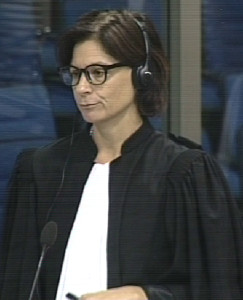
International Civil Party Lead Co-Lawyer Marie Guiraud
Mr. Koppe asked whether Chan was his superior. He replied that he saw Chan at Duch’s workplace and that it seemed that Chan was an assistant to Duch. Mr. Koppe wanted to show an excerpt of Chan’s notebook. Judge Lavergne inquired how he could establish that it was not obtained through torture.[16] Mr. Koppe said that they had found the English translation. At this point, Ms. Guiraud interjected and asked whether the page had been translated into English into French or English. Mr. Koppe clarified that the Khmer document had been partially translated into English and partially into French, but not the same parts. Mr. Koppe asked the witness whether he had looked at this excerpt. Mr. Koppe read out an excerpt: the group of A-Sot, A-Chhuk and A-Chakrei had plotted a coup. Later, according to this excerpt, A-Oeun had had also planned a plot. Mr. Koppe asked whether this correlated to his interrogation of Chhon. He replied that it had “nothing to do” with the confession of Meng alias Chhon. He insisted that he did not know about this plan, since it “was the business of the upper echelon”. He had learned about the arrest of particular individuals later. At this point, the President adjourned the hearing for a break.
After the break, Mr. Koppe apologized for the confusion about E3/833, and said that the document only did not show the ERNs, because of the printing format. When Mr. Koppe referred to a document from a female cadre to receive more information about a coup d’état staged by Koy Thuon, Mr. de Wilde interjected and said that Mr. Koppe had not laid sufficient information for saying that Koy Thuon had attempted a coup.[17] Mr. Koppe said that it had well been established, to which Judge Fenz said that nothing had been established until the Chamber had established it. Mr. Koppe then read the excerpt. This female cadre had talked about a plan for a coup d’état that was exposed and therefore failed and resulted in the arrest of Koy Thuon. Mr. Koppe asked whether this jogged the witness’s memory. Mr. Khan replied that he did not know about this. He did not know anything about someone having hid weapons. When Mr. Koppe asked about a plan to attack the airport or radio station, Mr. Khan said that some confessions mentioned this, but he had not known any plan about a coup d’état. Mr. de Wilde interjected and said that they now dealt with the content of confessions. Mr. Koppe replied that he could not control what the witness said.
He then asked whether he could recall who Koy Thuon was, which the witness could not. Mr. Koppe asked whether he knew who Koy Thuon, alias Khuon alias Tuch was. The witness replied that he only knew about him at the end of the regime. He had only heard of Oun’s name years after his arrest. He had heard that he was a former Division 310 commander. Mr. Koppe asked whether the answers by Chhon were spontaneous and not prompted by the interrogations. Mr. de Wilde interjected and said that the question was repetitive. Judge Fenz said that he was “dancing around the content”. The witness said that he wrote down the confession according to what the witness had said. Judge Lavergne argued that the witness had already said that the witness had already testified that he had to beat up the prisoner before getting a confession. The witness said that he wrote his confession before having been beaten, but since it seemed that the confession was incomplete, he beat him. He used hot and cold methods against this witness.
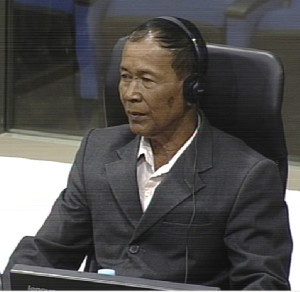
Witness Prak Khan
Mr. Koppe said that they would not argue that using “hot methods” and beating him was lawful, but that they could argue that the arrest of Chhon and his detention as such was lawful, because he was a suspect of a crime that would have been a crime in any country right now.
When conferring with the bench, Judge Fenz asked whether there was an open decision on what question was allowed. After the bench conferred further, the floor was given to Judge Fenz to make an oral ruling. Judge Fenz said that this question was prohibited under the decision on the use of documents obtained under torture.
He knew Sao Phim. He had shot himself to death, he said. He fled since Angkar wanted to arrest him, but since he could not escape, he shot himself to death. He did not know about any other incidents happening to Sao Phim. Mr. Koppe referred to Chan’s notebook, in which he had said that they were looking at information relating to meetings with Sao Phim that had “the footprints of the Vietnamese”.[18] He replied that he only saw the photograph of Sao Phim when he was shot dead.
Mr. Koppe then referred to the notebook of Pon and Tuy, where the writer referred to the “great victory over Sao Phim” as having the same value as 17 April.[19] Mr. Koppe inquired whether the defeat of Sao Phim was seen in such a category. The witness replied that he heard Duch talk about the defeat of Sao Phim. He had heard of the Workers’ Party of Kampuchea and said that this party was later known as the Communist Party of Kampuchea. Mr. Koppe wanted to know more about the Workers’ Party of Kampuchea and asked whether he had heard of this party that had been led by Koy Thuon, Ya, and others. Mr. Khan replied that he had not heard of this. He heard that the Vietnamese Communist party and the Communist Party of Kampuchea were competing about the victory of 17 April. The Communist Party of Kampuchea mentioned that they had a greater victory on 17 April 1975.
Mr. Koppe said that he had said yesterday that around 50 to 60 percent of detainees were interrogated and wanted to know how he had reached this number. Mr. Khan answered that this referred to the fewer numbers of interrogators. At this time, he was guarding the prisoners and could see that some prisoners remained in the cell without being sent anywhere for interrogation. The others “were waiting for the day to be killed”.
There were around thirty to forty female prisoners who had “never been sent out for interrogation”. Asked how he knew this, he said that he had witnessed it. Mr. Koppe pressed on and queried how he knew this if he was also interrogating prisoners at the time. He replied that he could see and witness those prisoners when he was bringing detainees back to their cells. Mr. Koppe asked again what his source of knowledge was for saying that such a big number of people had not been interrogated. Mr. Khan replied that it was his own conclusion, “because I have seen the prisoners at the time. You are grilling me on the issue, so that’s why I’m trying to give you a specific percentage”.
He remembered an individual called Man. Man was Cham, but could speak Khmer. He was killed later on. Mr. Koppe showed a photograph of Man to the witness. This was from Ysa Osman’ book Oukoubah.[20] He said that this was not Man. The Man that he knew was older and had a squared-shaped face.
Judge Lavergne wanted to ask some questions, but said that he did not want to interrupt Mr. Koppe’s questioning. Mr. Koppe said that he still wanted to deal with a few subjects: the blood-withdrawal, situation of women and children, and others. He said that he needed one more session to finish. Ms. Guissé said that she also needed one session for the Khieu Samphan Defense Team.
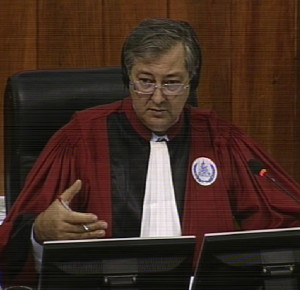
Judge Jean-Marc Lavergne
Judge Lavergne inquired about Colonel Keth Dara and asked whether he headed the so-called MONATIO-Movement. The witness did not know about this movement. Keth Dara had shot a few people and was arrested. He did not know what Keth Dara was engaged in. Judge Lavergne said that there were documents on the case file referred to a person called Hem Keth Dara had summoned journalists on 17 April 1975, during which he was seen with a revolver.[21] There was a photograph of this on the case file, which was shown to the witness. [22] He said he could not remember.
Judge Fenz announced that a decision about the time request would be made on Monday.
The President adjourned the hearing. It will continue Monday, May 2, 2016, at 9 am with the testimony of Prak Khan and witness 2-TCW-808.
[1] E3/833, p. 69 00282536 (FR), 00077729 (KH). 00282547 (FR), 00077740 (KH).
[2] Given the context, this must have been a translation error and rather meant that the Vietnamese were entering Cambodian territory.
[3] E399.
[4] E3/832, 00068921 (EN), 00068920 (KH).
[5] E3/2117, at 0008130 (EN).
[6] E3/965, at 00316312 (EN), 00068840 (KH), 00032430-36 (FR).
[7] E3/8778.
[8] E3/432.
[9] E3/8778, at 00989320-21.
[10] E3/13, at 00052414 (KH), 00940354-55 (EN), 00344983 (FR).
[11] E3/7639, at 00162734 and 366 (EN), 00162710 and 73 (KH), 00338076 and 79 (FR).
[12] E3/4260, at 00782984 (EN), 00257995 (KH). E3/1549, at 00697510 (EN)
[13] E3/1570, 00154192 (EN).
[14] E3/2007, at 0039568 (KH), 00223755 (KH) 00863798 (FR).
[15] E3/1549.
[16] E3/833, at 00077826 (KH), no French translation available. 00184579-00184618 (EN).
[17] E3/7540, at 00337712 (EN), 00055078 (KH), 00364274 (FR).
[18] E3/833, at 00184614 (EN), 00077946 (KH).
[19] E3/833, at 00077476 (KH), 00184483 (EN).
[20] E3/1822, at 00078508 (EN).
[21] E3/3365; E3/9749, notes by Sydney Shanberg at 00955412 (FR).
[22] E3/3939R, at 02:05. Published with article in Newsweek on 19 May 1975: E319/307, at 00445157 (FR).
Featured Image: Witness Prak Khan (ECCC: Flickr)
